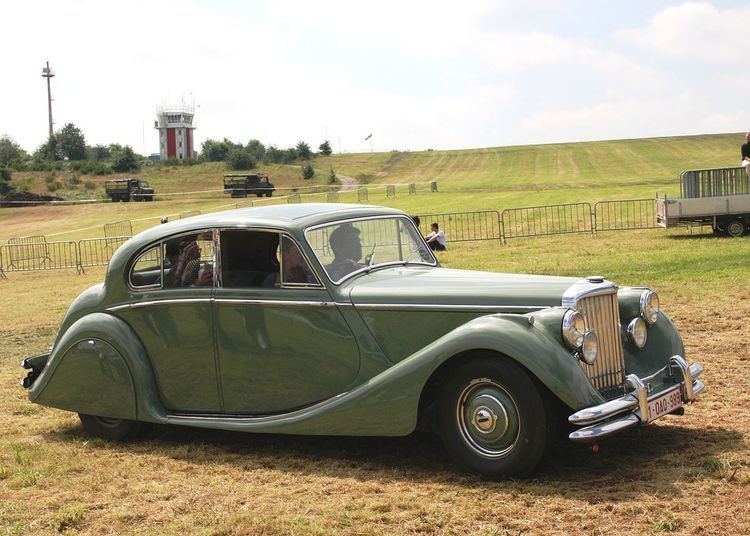Transmission four-speed manual | Production 1948–195110,499 Body style saloon, drophead coupé | |
 | ||
Engine 2664 cc or 3485 cc straight-6 pushrod ohv | ||
The Jaguar Mark V (pronounced mark five) and always printed in company documents as a Roman numeral V, never an Arabic number 5, is an automobile built by Jaguar Cars Ltd from 1948 to 1951.
The Mark V was introduced to distributors and the press on 30 September 1948 and launched on 27 October 1948 at the London Motor Show at the same time as the XK120, with which it shared a stand. The XK120 stole the show. However, the Mark V vastly outsold the XK120 by roughly 5,000 cars per year as compared to 2,000 cars per year for the XK120. While the XK120 had a new overhead-camshaft XK engine, the Mark V retained the 1946-48 driveline including the overhead-valve pushrod straight-6 2½L and 3½L engines, now since 1946 produced by Jaguar, which the company had previously purchased from the Standard Motor Company before the war, and the four-speed single-helical gearbox produced by both Jaguar and the Moss Gear Company of Birmingham. The 1½L Standard engine used in previous models was not offered in the Mark V. Claimed power output in this application was 104 bhp (78 kW) for the 2664 cc Mark V and 126 bhp (94 kW) for its more popular 3486 cc sibling. The chassis was new with independent front suspension by double wishbones and torsion bar, an arrangement that would be used by Jaguar for many future vehicles. It also had hydraulic brakes, which Jaguar had been slow to adopt compared to other manufacturers, and an all pressed steel body.
The styling of the car followed prewar SS-Jaguar lines with upright chrome grille and the leaping Jaguar radiator cap mascot became available as an option. There is a distinct hint of the recently modernised Bentley look in the style of the front grill.
The wheels were 16-inch (410 mm) steel-disc type, significantly smaller than the 18-inch (460 mm) wheels on the MK IV. From the side, a distinctive styling touch on the saloon was a "tuck in" curve at the base of the rear quarter window following the curved profile of the side glass, a feature retained on many subsequent models. Rear-wheel spats (fender skirts) were standard. There was also a drophead coupé version.
A 3½ litre car tested by The Motor magazine in 1949 had a top speed of 90.7 mph (146.0 km/h) and could accelerate from 0–60 mph (97 km/h) in 20.4 seconds. Jaguar's inimitable test engineer Norman Dewis used a Mark V regularly. When asked about the top speed he saw in his car, he commented that he verified 90 mph once, but the thrill of the moment did not encourage repeating the feat. A fuel consumption of 18.2 miles per imperial gallon (15.5 L/100 km; 15.2 mpg‑US) was recorded. The test car cost £1263 including taxes.
Production figures were:
sum total 10,499
In 1951 the Mark V was replaced by the Jaguar Mark VII. The Mark VII had the same 10-foot (3.0 m) wheelbase as the Mark V, but a longer and more streamlined-looking body, which continued in production with little outward change through the Jaguars Mark VIII and Mark IX until 1961.
The Mark V name
The origin of the Mark V name is somewhat mysterious as there had been no Mk I to IV Jaguars and the MK IV designation was only given to its predecessor after the launch of the Mk V. Chairman and chief stylist William Lyons (Sir William after 1956) and his team of shop assistants known as panel beaters put together five prototype bodies with various chassis experiments in the 1946-1948 period before he was satisfied with the result, and the chosen one was known as Mark V in internal documents. Lyons explained this in a speech given on September 30 1948 to introduce the new car to distributors and members of the press, so that is how the Mark V got its name. A photograph of the discarded prototypes survives with the Jaguar Daimler Heritage Trust.
